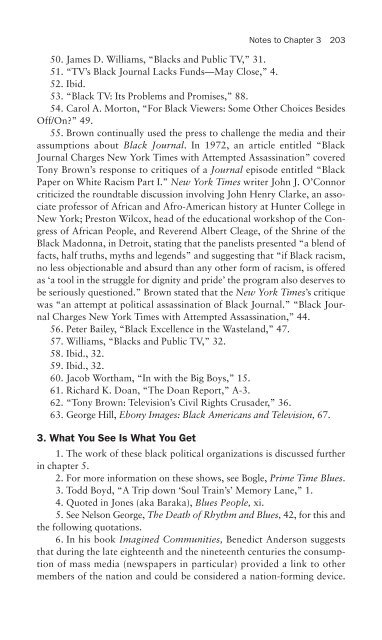Revolution Televised.pdf
Revolution Televised.pdf
Revolution Televised.pdf
Create successful ePaper yourself
Turn your PDF publications into a flip-book with our unique Google optimized e-Paper software.
50. James D. Williams, “Blacks and Public TV,” 31.<br />
51. “TV’s Black Journal Lacks Funds—May Close,” 4.<br />
52. Ibid.<br />
53. “Black TV: Its Problems and Promises,” 88.<br />
54. Carol A. Morton, “For Black Viewers: Some Other Choices Besides<br />
Off/On?” 49.<br />
55. Brown continually used the press to challenge the media and their<br />
assumptions about Black Journal. In 1972, an article entitled “Black<br />
Journal Charges New York Times with Attempted Assassination” covered<br />
Tony Brown’s response to critiques of a Journal episode entitled “Black<br />
Paper on White Racism Part I.” New York Times writer John J. O’Connor<br />
criticized the roundtable discussion involving John Henry Clarke, an associate<br />
professor of African and Afro-American history at Hunter College in<br />
New York; Preston Wilcox, head of the educational workshop of the Congress<br />
of African People, and Reverend Albert Cleage, of the Shrine of the<br />
Black Madonna, in Detroit, stating that the panelists presented “a blend of<br />
facts, half truths, myths and legends” and suggesting that “if Black racism,<br />
no less objectionable and absurd than any other form of racism, is offered<br />
as ‘a tool in the struggle for dignity and pride’ the program also deserves to<br />
be seriously questioned.” Brown stated that the New York Times’s critique<br />
was “an attempt at political assassination of Black Journal.” “Black Journal<br />
Charges New York Times with Attempted Assassination,” 44.<br />
56. Peter Bailey, “Black Excellence in the Wasteland,” 47.<br />
57. Williams, “Blacks and Public TV,” 32.<br />
58. Ibid., 32.<br />
59. Ibid., 32.<br />
60. Jacob Wortham, “In with the Big Boys,” 15.<br />
61. Richard K. Doan, “The Doan Report,” A-3.<br />
62. “Tony Brown: Television’s Civil Rights Crusader,” 36.<br />
63. George Hill, Ebony Images: Black Americans and Television, 67.<br />
3. What You See Is What You Get<br />
Notes to Chapter 3 203<br />
1. The work of these black political organizations is discussed further<br />
in chapter 5.<br />
2. For more information on these shows, see Bogle, Prime Time Blues.<br />
3. Todd Boyd, “A Trip down ‘Soul Train’s’ Memory Lane,” 1.<br />
4. Quoted in Jones (aka Baraka), Blues People, xi.<br />
5. See Nelson George, The Death of Rhythm and Blues, 42, for this and<br />
the following quotations.<br />
6. In his book Imagined Communities, Benedict Anderson suggests<br />
that during the late eighteenth and the nineteenth centuries the consumption<br />
of mass media (newspapers in particular) provided a link to other<br />
members of the nation and could be considered a nation-forming device.

















